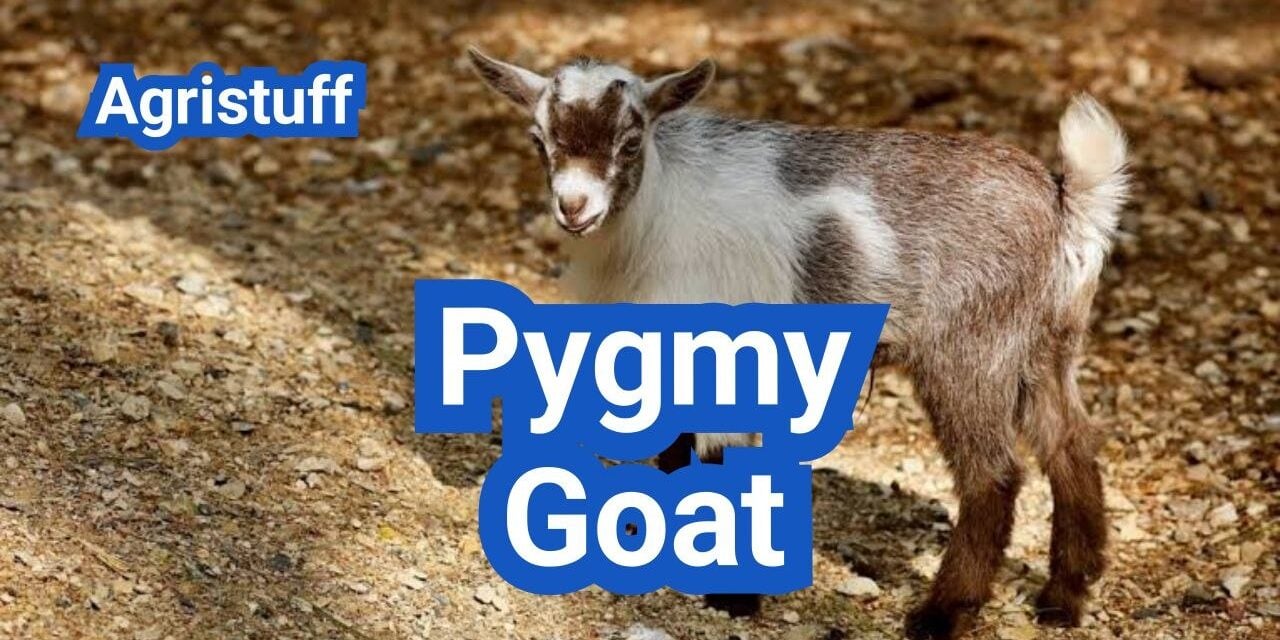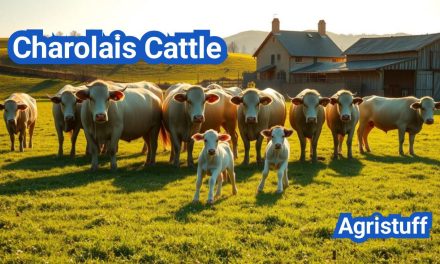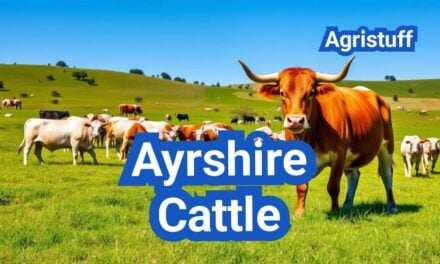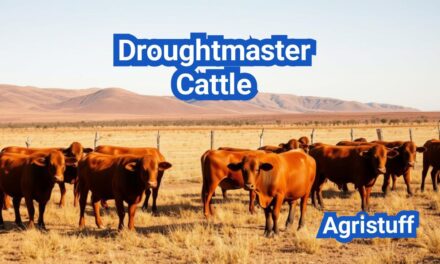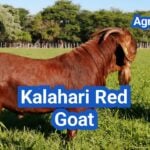The American Pygmy Goat is a popular breed known for its small size and social nature. Originating from West African Dwarf goats, these miniature goats have gained popularity worldwide due to their friendly and adaptable personalities.
The history and origin of miniature goats are closely tied to their development as a distinct breed. With their compact size and gentle disposition, they have become a favorite among many animal enthusiasts and farmers.
Understanding the characteristics of these goats is essential for anyone looking to raise them. Their breeding and uses are also important aspects to consider, making a comprehensive guide a valuable resource for those interested in this breed.
Key Takeaways
- Originated from West African Dwarf goats
- Known for their small size and social nature
- Popular worldwide due to friendly and adaptable personalities
- Compact size and gentle disposition make them a favorite among animal enthusiasts
- Understanding their characteristics is essential for raising them
Understanding the Pygmy Goat Breed
As a distinct breed, Pygmy goats offer a range of benefits and characteristics that make them an attractive choice for various purposes. Their versatility and unique traits have contributed to their growing popularity worldwide.
Definition and Basic Overview
The Pygmy goat is a small, sturdy breed known for its compact size and robust health. Originating from West Africa, they have been introduced to various parts of the world and have adapted well to different environments. Pygmy goats are recognized for their docile nature, making them an excellent choice for both novice farmers and families.
Popularity as Pets and Farm Animals
Pygmy goats have gained popularity not only as pets but also as valuable farm animals. Their manageable size and gentle disposition make them ideal for small farms and homesteads. Here are some reasons for their popularity:
- Their small size makes them suitable for areas with limited space.
- They are relatively low maintenance compared to larger livestock.
- Pygmy goats are known for their friendly and social nature, making them great companions.
- They can be used for milk, meat, or as part of a diverse farm ecosystem.
Lifespan Expectations
Pygmy goats are known to have a relatively long lifespan for their size, typically living between 10 to 15 years. Proper care, including a balanced diet, regular veterinary check-ups, and a safe living environment, can contribute to a long and healthy life. Factors such as genetics, nutrition, and healthcare play significant roles in determining an individual Pygmy goat’s lifespan.
The History and Origin of Pygmy Goats

With roots tracing back to West Africa, Pygmy goats have evolved into a distinct breed. Their history is a fascinating tale of migration and adaptation.
West African Origins
Pygmy goats originated from the West African Dwarf goat breed. These goats were known for their hardiness and ability to thrive in challenging environments. The West African Dwarf goats were small in stature but robust, characteristics that were retained in the Pygmy goats bred in other parts of the world.
Introduction to the United States
Pygmy goats were introduced to the United States in the 1950s, marking the beginning of their development as a recognized breed in the country. They were initially kept in zoos and later became popular as pets and farm animals due to their manageable size and friendly nature.
Development as a Recognized Breed
Over the years, breeders in the United States worked to establish Pygmy goats as a distinct breed. This involved selective breeding to enhance desirable traits such as their size, coat, and temperament. The efforts of breeders led to the recognition of Pygmy goats by various agricultural and animal registries.
The National Pygmy Goats Association
The National Pygmy Goats Association (NPGA) was established to promote the breed and maintain breed standards. The NPGA provides registration services for Pygmy goats, ensuring that the breed’s integrity is maintained. The association also supports breeders and owners by providing information and resources on the care and management of Pygmy goats.
Physical Characteristics of Pygmy Goats
Pygmy goats have several distinct physical attributes that set them apart from other goat breeds. Their compact size, robust build, and varied coat colors make them a popular choice for both hobby farmers and those looking for a unique pet.
Size and Weight Standards
Pygmy goats are known for their small stature. Males typically weigh between 60-86 pounds and stand between 16-23 inches tall at the withers. Females are generally smaller, weighing between 50-75 pounds and standing between 16-22 inches tall. These dimensions are crucial for breeders and owners to understand, as they form the basis of the breed standard.
| Gender | Weight (lbs) | Height (inches) |
|---|---|---|
| Male | 60-86 | 16-23 |
| Female | 50-75 | 16-22 |
Coat Colors and Patterns
Pygmy goats exhibit a wide range of coat colors and patterns, adding to their visual appeal. Common colors include black, brown, red, and white, often in various combinations. The coat can be solid, spotted, or patterned, making each goat unique. The diversity in coat colors is one of the breed’s attractive features.
Distinctive Features
Aside from their size and coat, Pygmy goats have several distinctive physical features. They have a broad head, a short, straight muzzle, and erect ears. Their horns are typically straight or slightly curved and are present in both males and females. The sturdy build and robust health of Pygmy goats contribute to their popularity.
Conformation Requirements
The conformation of Pygmy goats is crucial for their overall health and functionality. A well-conformed Pygmy goat should have a sturdy body, straight legs, and a strong back. The breed standard emphasizes the importance of a compact, well-proportioned body, which is essential for their agility and overall well-being.
Pygmy Goat Temperament and Behavior

One of the defining characteristics of Pygmy goats is their friendly and docile nature. Pygmy goat temperament is often described as gentle and affectionate, making them an excellent choice as pets.
Personality Traits
Pygmy goats are known for their curious and playful personalities. They are highly interactive and enjoy human company, often seeking attention and affection. As quoted by experienced breeders, “Pygmy goats are like having a constant companion; they follow you around and love to be involved in whatever you’re doing.”
Their friendly nature makes them suitable for a variety of settings, including farms and homes with children. However, it’s essential to handle them gently and with care to maintain their trusting nature.
Social Behavior
Pygmy goats are highly social animals that thrive in the company of others. They live in a hierarchical structure, with dominant goats leading the way. This social behavior is crucial for their emotional well-being, and they require companionship to stay happy and healthy.
As social creatures, Pygmy goats communicate with each other through a variety of sounds and body language. They are known to form close bonds with other goats and even other animals on the farm.
“Goats are very social animals and need to be with other goats. They get lonely and stressed if they are alone for too long.”
Intelligence and Trainability
Pygmy goats are highly intelligent and can be trained with ease. They are known to learn quickly and respond well to positive reinforcement. Training should be consistent and gentle, as they can be sensitive to harsh treatment.
Their intelligence also means they can be quite mischievous if not provided with adequate stimulation and activities. Engaging them in puzzle toys or providing a variety of environments can help keep them entertained and stimulated.
Overall, the pygmy goat behavior is a combination of their natural curiosity, social nature, and intelligence, making them a joy to be around and care for.
How to Select and Purchase a Healthy Pygmy Goat
When buying a Pygmy Goat, it’s crucial to assess its health and the breeder’s reputation. A healthy Pygmy Goat is not only a joy to own but also a sound investment for any farm or homestead.
Physical Signs of Health
A healthy Pygmy Goat should exhibit certain physical characteristics. Look for alertness and activity; a healthy goat should be curious and energetic. Check the goat’s eyes for brightness and clarity, and ensure there are no signs of discharge or redness. The coat should be shiny and well-maintained, indicating good health and nutrition.
Inspect the goat’s hooves for any signs of damage or disease. Overgrown or cracked hooves can be a sign of neglect or health issues. Also, check for any signs of parasites or skin conditions.
Questions to Ask Breeders
When purchasing a Pygmy Goat, it’s essential to ask the breeder the right questions. Inquire about the goat’s health history, including any vaccinations or medical treatments it has received. Ask about the goat’s diet and living conditions to ensure it has been well cared for.
It’s also crucial to ask about the goat’s pedigree and any registration documents available. This information can be vital for breeding purposes or for verifying the goat’s lineage.
Documentation and Registration
Ensure that your Pygmy Goat is properly registered with a recognized breed association, such as the National Pygmy Goats Association (NPGA). Registration provides proof of the goat’s pedigree and is essential for breeding and showing purposes.
Also, ask for health certificates and records of any vaccinations or deworming treatments. These documents are crucial for maintaining the health of your goat and ensuring compliance with local regulations.
Average Costs in the USA
The cost of a Pygmy Goat in the USA can vary widely depending on factors such as age, quality, and pedigree. On average, you can expect to pay between $200 to $500 for a pet-quality Pygmy Goat. Breeding stock or show-quality goats can cost significantly more, often ranging from $500 to $1,500 or more.
Consider not only the initial purchase price but also the ongoing costs of care, including feed, veterinary care, and supplies. Understanding these costs will help you make an informed decision when buying a Pygmy Goat.
Setting Up Proper Housing and Fencing

Pygmy Goats require specific housing and fencing to protect them from predators and harsh weather conditions. Providing a safe and comfortable environment is crucial for their well-being.
Shelter Requirements
Adequate shelter is essential for protecting Pygmy Goats from extreme temperatures, rain, and wind. The shelter should be well-ventilated, dry, and draft-free. A simple three-sided shelter or a barn can be used, ensuring that it is sturdy and secure.
Fencing Considerations
Fencing is a critical aspect of Pygmy Goat housing. The fence should be at least 4 feet high to prevent escape and predator entry. High-tensile wire or woven wire fencing is recommended. The fencing material should be durable and resistant to damage from the goats’ horns and hooves.
Space Needs
Pygmy Goats require sufficient space to move around, exercise, and engage in natural behaviors. A minimum of 200 square feet per goat is recommended for their enclosure. The area should be well-drained and free from hazards.
Bedding and Cleaning Routines
Bedding material such as straw or hay should be provided to keep the shelter clean and dry. Regular cleaning is necessary to prevent health issues. The bedding should be changed frequently, and the shelter should be cleaned regularly to maintain hygiene.
By focusing on these aspects, you can create a safe and healthy environment for your Pygmy Goats, ensuring their overall well-being and happiness.
Complete Feeding and Nutrition Guide

Pygmy goats are browsers and need a diet that is rich in fiber, including plenty of hay and forage, to stay healthy. Their dietary needs are unique and require a balanced mix of nutrients to maintain their overall health and well-being.
Basic Diet Requirements
The basic diet for pygmy goats should include high-quality hay, forage, and limited amounts of grain. Hay is a crucial component, providing fiber and helping to keep their digestive system healthy. It’s recommended to provide a variety of hay types, such as timothy hay or alfalfa hay, to ensure a broad spectrum of nutrients.
Hay and Forage
Hay and forage are essential for pygmy goats, making up the bulk of their diet. Forage includes grasses, leaves, and other vegetation that pygmy goats love to browse on. Ensuring access to fresh, clean forage is vital for their nutritional balance. A mix of different forages can help prevent dietary boredom and ensure they receive a wide range of nutrients.
Grain and Supplements
While hay and forage are the mainstays of a pygmy goat’s diet, grain can be used as a supplement to provide additional nutrients. However, it’s crucial to limit the amount of grain to avoid overfeeding, which can lead to health issues like obesity. Supplements can also be added to their diet if necessary, but it’s best to consult with a veterinarian to determine the specific needs of your pygmy goats.
Water Requirements
Access to clean, fresh water is essential for pygmy goats at all times. Water intake is crucial for their overall health, affecting digestion, nutrient absorption, and body temperature regulation. Ensuring that water containers are clean and easily accessible can help prevent health issues.
| Nutrient | Recommended Amount | Source |
|---|---|---|
| Fiber | High | Hay, Forage |
| Protein | Moderate | Grain, Alfalfa Hay |
| Energy | Balanced | Grain, Hay |
| Water | Unlimited Access | Clean Water Containers |
By understanding and meeting the dietary needs of pygmy goats, owners can help ensure their animals lead healthy, happy lives. A balanced diet, combined with proper care and regular veterinary check-ups, is key to maintaining the overall well-being of these wonderful animals.
Common Health Issues and Preventative Care

Pygmy goats, like other livestock, are prone to specific health issues that require attention and care. Maintaining their health is crucial for their overall wellbeing and productivity.
Routine Health Maintenance
Regular health checks are vital for early detection of potential health issues in pygmy goats. This includes monitoring their overall condition, checking for signs of illness or injury, and ensuring they are up-to-date on all preventative care measures.
Key aspects of routine health maintenance include regular hoof trimming to prevent hoof rot and lameness, inspecting their coats for signs of parasites, and checking their eyes and ears for any signs of infection.
Vaccinations and Deworming
Vaccinations play a critical role in protecting pygmy goats from diseases such as Clostridium perfringens and Clostridium tetani. Deworming is also essential to control internal parasites.
- Regular vaccinations should be administered according to a schedule recommended by a veterinarian.
- Deworming should be done based on fecal egg counts to determine the parasite load.
| Vaccination/Deworming Schedule | Frequency | Notes |
|---|---|---|
| CDT Vaccination | Annually | Boosters may be needed based on risk assessment |
| Deworming | Quarterly or as needed | Fecal egg counts should guide the frequency |
Signs of Illness
Recognizing signs of illness in pygmy goats is crucial for prompt intervention. Common signs include lethargy, loss of appetite, diarrhea, and labored breathing.
If any of these symptoms are observed, it is essential to consult a veterinarian promptly to determine the cause and appropriate treatment.
When to Call a Veterinarian
It’s crucial to know when to seek veterinary care. If a pygmy goat shows severe symptoms such as difficulty breathing, severe diarrhea, or signs of pain, immediate veterinary attention is necessary.
Regular veterinary care and preventative measures can significantly reduce the risk of common health issues in pygmy goats, ensuring they lead healthy and productive lives.
Breeding Pygmy Goats: A Step-by-Step Guide

Breeding Pygmy goats is a rewarding experience that requires careful planning and attention to detail. To achieve success, breeders must consider several factors, including the selection of high-quality breeding stock, understanding the breeding process, and providing appropriate care during pregnancy and kidding.
Selecting Breeding Stock
Selecting the right breeding stock is crucial for the success of a Pygmy goat breeding program. Healthy, genetically diverse animals with good conformation are essential. Breeders should look for goats that are free from genetic disorders and have a strong pedigree.
The selection process involves evaluating the physical characteristics, temperament, and reproductive health of potential breeding goats. It’s also important to consider the breed standards and the goals of the breeding program.
The Breeding Process
The breeding process for Pygmy goats typically involves introducing a doe to a buck during her estrus cycle. Understanding the doe’s reproductive cycle is vital to determine the optimal breeding time. The gestation period for Pygmy goats is approximately 150 days.
Successful breeding requires careful planning, including arranging for a suitable buck and monitoring the doe’s health during pregnancy.
Pregnancy and Kidding
During pregnancy, it’s essential to provide the doe with proper nutrition and healthcare. Regular veterinary check-ups can help identify any potential issues early on.
Kidding is a critical phase, and breeders should be prepared to assist if necessary. Ensuring a clean and safe environment for kidding is vital for the health of both the doe and the kids.
Care of Newborn Kids
Newborn Pygmy goat kids require immediate care, including colostrum intake within the first hour of birth. Monitoring their health and ensuring they are nursing properly is crucial.
Breeders should also be prepared to provide any necessary interventions, such as vaccinations and deworming, to ensure the kids grow into healthy adults.
Raising and Caring for Baby Pygmy Goats
Caring for baby Pygmy goats requires attention to detail and a commitment to providing the best possible start in life. These adorable creatures demand specialized care to ensure their health and well-being.
First 24 Hours of Care
The first 24 hours are critical for baby Pygmy goats. Ensuring they receive adequate colostrum is paramount. Colostrum, rich in antibodies, provides newborn kids with their initial immunity against diseases. It’s essential to monitor the kids’ weight and overall health during this period.
Bottle Feeding vs. Dam Raising
Deciding between bottle feeding and dam raising depends on several factors, including the health of the doe and the number of kids. Dam raising is generally preferred as it allows for natural bonding and reduces the risk of disease transmission. However, bottle feeding may be necessary if the doe is unable to nurse or if there are too many kids.
Weaning Process
Weaning typically occurs between 8 to 10 weeks of age. It’s a gradual process that involves reducing the kids’ reliance on milk or formula. Introducing solid foods early can help facilitate a smoother weaning process.
Health Monitoring for Kids
Regular health checks are vital for detecting any potential issues early. Monitoring includes checking for signs of illness, ensuring proper growth, and administering vaccinations as necessary.
| Age | Care Requirements | Health Checks |
|---|---|---|
| 0-24 hours | Ensure adequate colostrum intake | Weight check, overall health assessment |
| 1-8 weeks | Bottle feeding or dam raising, introduction to solid foods | Regular weight checks, monitoring for signs of illness |
| 8-10 weeks | Gradual weaning | Continued health monitoring, vaccination as necessary |
Multiple Uses of Pygmy Goats

Pygmy goats serve multiple purposes, making them a valuable addition to any farm or family. Their versatility is one of their most appealing qualities, offering a range of benefits whether kept as pets, used for milk and meat production, or showcased in 4-H projects.
Pygmy Goats as Pets
Pygmy goats have gained popularity as pets due to their friendly and affectionate nature. They are relatively small, making them suitable for smaller properties or homesteads. Their intelligence and trainability also make them a joy to interact with, as they can be taught to walk on a leash or perform simple tricks.
Keeping pygmy goats as pets requires a commitment to providing proper care, including adequate housing, nutrition, and regular veterinary check-ups. However, the rewards are numerous, as they can form strong bonds with their owners and provide endless entertainment.
Milk Production and Quality
While pygmy goats are not as prolific in milk production as some other breeds, they still offer a respectable quantity and quality of milk. On average, a pygmy goat can produce around 1-2 quarts of milk per day, which is rich in butterfat and suitable for making cheese, butter, and other dairy products.
The milk of pygmy goats is known for its nutritional value, containing essential vitamins and minerals. Some dairy enthusiasts appreciate the unique flavor profile it adds to various dairy products.
Meat Production
Pygmy goats are also raised for their meat, which is considered a delicacy in many cultures. The meat is lean and tender, making it a healthy alternative to traditional red meats. Pygmy goat meat is often used in specialty dishes and is prized for its unique flavor.
Breeding pygmy goats for meat production requires careful selection of breeding stock to ensure desirable traits such as growth rate and meat quality.
4-H Projects and Shows
Pygmy goats are a popular choice for 4-H projects due to their manageable size and the educational opportunities they provide. Children can learn valuable skills in animal husbandry, including feeding, grooming, and showing their goats.
Participating in 4-H projects with pygmy goats not only teaches children about responsibility and animal care but also fosters a sense of community and competition in a positive environment.
Pygmy Goats vs. Nigerian Dwarf Goats: Key Differences

For those looking to add a small goat breed to their farm or homestead, understanding the differences between Pygmy goats and Nigerian Dwarf goats is crucial. Both breeds have gained popularity due to their compact size and unique characteristics, but they serve different purposes and have distinct traits.
Size and Appearance Comparison
Pygmy goats are known for their stocky build and compact body, typically weighing between 50 to 100 pounds. Nigerian Dwarf goats, on the other hand, are slender and often weigh less, typically ranging from 20 to 40 pounds. The coat colors and patterns can vary in both breeds, but Pygmy goats tend to have a more uniform appearance.
Temperament Differences
Pygmy goats are often described as friendly and sociable, making them excellent pets. Nigerian Dwarf goats are also known for their friendly nature but can be more energetic and require more attention. Both breeds are intelligent and can be trained, but their temperament can vary based on individual personalities and breeding.
“Goats are intelligent and curious animals, and both Pygmy and Nigerian Dwarf goats can be trained to walk on a leash and perform tricks.”
Production Capabilities
One of the significant differences between Pygmy goats and Nigerian Dwarf goats lies in their production capabilities. Nigerian Dwarf goats are known for their high milk production relative to their size, making them a popular choice for dairy purposes. Pygmy goats, while they can be milked, are not as prolific in their milk production. Pygmy goats are often raised for meat or as pets.
- Pygmy goats: Primarily raised for meat or as pets.
- Nigerian Dwarf goats: Known for their dairy production capabilities.
Which Breed Is Right for You?
The choice between Pygmy goats and Nigerian Dwarf goats depends on your specific needs and preferences. If you’re looking for a pet or a breed for meat production, Pygmy goats might be the better choice. For those interested in dairy production, Nigerian Dwarf goats are more suitable due to their higher milk yield.
Key Considerations:
- Purpose: Pet, meat, or dairy production.
- Space and Resources: Consider the space and resources you have available.
- Care and Management: Understand the specific care and management needs of each breed.
Is the Pygmy Goat Right for You?
Pygmy goats are a unique breed that can make excellent pets or farm animals for the right owner. After exploring their history, characteristics, and uses, it’s clear that they offer a rewarding experience for those willing to invest time and care.
When considering getting started with pygmy goats, it’s essential to evaluate your lifestyle, available space, and the level of care you can provide. These goats require proper housing, nutrition, and health care, but in return, they can offer companionship, milk, or meat, depending on your goals.
If you’re looking for a pet that is social, intelligent, and relatively low maintenance compared to larger livestock, the pygmy goat might be an ideal choice. Their small size and manageable needs make them a great option for small farms or homesteads.
As you ponder whether a pygmy goat is right for you, refer to this pygmy goat guide to ensure you’re making an informed decision. With the right preparation and understanding, owning pygmy goats can be a fulfilling experience, providing joy and utility for years to come.
FAQ
What is the origin of Pygmy Goats?
Pygmy Goats originated from West Africa, where they were bred for their meat, milk, and hide. They were later introduced to the United States, where they were developed into a recognized breed.
What are the physical characteristics of Pygmy Goats?
Pygmy Goats are small in size, with adults typically weighing between 50-100 pounds and standing between 16-23 inches tall. They have a stocky build, a broad head, and a short, smooth coat that comes in a variety of colors.
What is the temperament of Pygmy Goats?
Pygmy Goats are known for their friendly, curious, and playful personalities. They are social animals that thrive on interaction and can become quite affectionate with their owners.
How do I select a healthy Pygmy Goat?
When selecting a Pygmy Goat, look for signs of good health such as bright eyes, a clean coat, and a robust appetite. Ask the breeder about the goat’s history, including its vaccination record and any health issues.
What are the housing and fencing needs for Pygmy Goats?
Pygmy Goats require sturdy fencing that is at least 4 feet tall to prevent escape. They need shelter from the elements, such as a barn or three-sided shelter, and adequate space to roam and exercise.
What do Pygmy Goats eat?
Pygmy Goats are ruminants and require a diet of high-quality hay, grass, and grains. They also need access to fresh water at all times.
How often should I vaccinate and deworm my Pygmy Goats?
Pygmy Goats should be vaccinated annually against diseases such as CDT. Deworming should be done regularly, ideally every 2-3 months, depending on the goat’s health and parasite load.
Can Pygmy Goats be used for milk and meat production?
Yes, Pygmy Goats can be used for both milk and meat production, although their milk production is generally lower than that of dairy breeds.
How do I breed Pygmy Goats?
Breeding Pygmy Goats requires careful selection of breeding stock, a well-planned breeding program, and proper care for the doe and kids during and after kidding.
What are the key differences between Pygmy Goats and Nigerian Dwarf Goats?
Pygmy Goats are generally smaller and more compact than Nigerian Dwarf Goats, with a more rugged build. Nigerian Dwarf Goats are known for their higher milk production and more refined features.
Are Pygmy Goats suitable as pets?
Yes, Pygmy Goats can make excellent pets for those who are willing to provide the necessary care and attention. They are social, friendly, and relatively low-maintenance.
How long do Pygmy Goats live?
Pygmy Goats can live for 10-15 years or more with proper care and management.
Conclusion of: Pygmy Goat Breed In The U.S.
The Pygmy Goat is one of the most recognizable miniature goat breeds in the world, and for many small farmers and homesteaders in the United States the Pygmy Goat is the perfect blend of hardy livestock and friendly companion. Originating from West Africa and later standardized as a distinct breed, the Pygmy Goat offers compact size, good feed efficiency, rich milk, and an engaging personality that fits well on small acreages, suburban backyards, and educational farms. For anyone considering goats for pets, light milk production, small-scale meat, or brush control, understanding the Pygmy Goat is an important first step toward responsible ownership and successful management. Colorado State University Extension
History and Origin of the Pygmy Goat
The modern Pygmy Goat traces its roots to the West African Dwarf goat, a hardy landrace that developed in the humid forest zones of West and Central Africa. Over many generations, these small goats adapted to challenging tropical conditions, with the compact body and short legs of the Pygmy Goat helping the animals cope with heat, humidity, parasites, and limited forage. This ancestral background explains why the Pygmy Goat is such a tough little animal today, capable of thriving in a variety of environments across the United States when given basic good care. West African Dwarf Goat – Wikipedia
During the twentieth century, foundation stock for the Pygmy Goat was exported from West Africa to European zoos, where the goats were kept as exotic exhibits and research animals. Later, in the 1950s and 1960s, Pygmy Goat lines were imported from Europe to the United States, where game farms, research facilities, and private breeders quickly recognized the appeal of these small, personable goats. As interest grew, American breeders worked together to create a formal registry and consistent breed standard for the Pygmy Goat, eventually establishing a recognized miniature breed with documented history and predictable characteristics. Pygmy Goat – Wikipedia
Official Breed Standard and General Characteristics of the Pygmy Goat
According to established breed organizations, the Pygmy Goat is genetically small, cobby, and compact, with a broad chest, well-sprung ribs, and heavy muscling for its height. Overall, a Pygmy Goat stands roughly 16–23 inches (40–58 cm) at the withers, giving it a short, sturdy profile that is very different from the taller, narrower dairy breeds. The short legs, rounded body, and strong bone of the Pygmy Goat create the impression of a powerful little animal that looks balanced and athletic rather than frail or fragile, which is one of the reasons people like to raise the breed around children and beginners. National Pygmy Goat Association (NPGA)
Coat and color are also distinctive features of the Pygmy Goat. The breed appears in several agouti-based color patterns, including various shades of caramel, gray, and black, often with contrasting facial stripes, leg markings, and a darker dorsal stripe. The hair of the Pygmy Goat is generally straight and medium length, with a dense undercoat that becomes thicker in winter and may shed out heavily in spring. Bucks often show a more pronounced mane over the shoulders and neck, while both sexes of Pygmy Goat normally carry horns unless breeders intentionally select polled lines or disbud kids for safety and show requirements. Pygmy Goat Club (UK)
Temperament is another major reason the Pygmy Goat has become popular in the United States. Well-socialized animals are typically curious, alert, and friendly, and a Pygmy Goat that is handled often will usually enjoy interaction, grooming, and hand-feeding. Because the Pygmy Goat is smaller and easier to restrain than standard-size goats, it is commonly chosen for family homesteads, youth projects, therapy programs, and petting zoos. As with any breed, early handling, consistent routines, and gentle training help keep the Pygmy Goat calm and cooperative throughout its life. Goat Journal
Pygmy Goat vs. Other Miniature Goat Breeds
Although many people use the term “miniature goat” loosely, the Pygmy Goat is quite different from other small breeds, especially the Nigerian Dwarf. The Pygmy Goat is short and thick-bodied, with a build that is closer to a small meat goat, while the Nigerian Dwarf is more refined and angular, with a conformation similar to a standard dairy goat. Both can be excellent small-farm animals, but the Pygmy Goat is usually selected for its personality, hardiness, and compact size rather than for high-volume milk production, making it better suited for backyard pets and hobby herds than for commercial dairy operations. Nigerian Dwarf Goat – Wikipedia
Main Uses of the Pygmy Goat in the U.S.
The most common role of the Pygmy Goat in the United States is that of a companion or family pet. Because the Pygmy Goat is small, personable, and generally gentle, it fits well into suburban and small-acreage settings where owners want daily interaction with their animals. When kept in pairs or small groups, a Pygmy Goat will often follow people around, seek attention, and quickly learn the routine of feeding and turnout, making it a rewarding “backyard livestock” option for people who do not have room for full-size goats but still want a genuine farm experience. ThoughtCo
Beyond companionship, the Pygmy Goat can provide a modest amount of milk for household use. A well-managed Pygmy Goat doe may produce enough high-butterfat milk for drinking, yogurt, simple cheeses, and homemade soap, which is attractive to homesteaders who value self-sufficiency more than raw volume. Because the Pygmy Goat is not bred for extreme milk production, its nutritional needs are easier to meet on small properties, and the smaller udder size can be less intimidating for beginners learning to hand-milk for the first time. Goats Extension (USA)
In some operations, the Pygmy Goat also contributes to meat and land management. Although the carcass of a Pygmy Goat is smaller than that of standard meat breeds, the dense muscling and efficient feed conversion can make the breed useful in niche meat markets or home freezers, especially when crossed with other goats. In addition, a small herd of Pygmy Goat animals can help manage brush and weeds on small acreages, and many farms feature the Pygmy Goat in petting zoos, agritourism programs, and youth shows where calm, small animals are a priority. Oklahoma State University Extension
Housing and Fencing Requirements for the Pygmy Goat
Even though the Pygmy Goat is tough and adaptable, proper housing and fencing are essential for safety and welfare. Every Pygmy Goat needs a dry, draft-free shelter that protects from rain, wind, and extreme temperatures, with enough room for all goats to lie down comfortably and move away from more dominant herd mates. Good ventilation, clean bedding, and secure latches are important, because a Pygmy Goat is curious, agile, and very capable of testing weak doors or loose boards, especially when hungry or bored. Oregon State University Extension
Fencing is another critical piece of infrastructure for the Pygmy Goat. The breed’s small size and nimble body mean that a Pygmy Goat can slip through large gaps or climb on unstable structures if they are available. Most owners use woven wire, cattle panels with additional mesh, or properly stretched field fence at least 4 feet high to keep a Pygmy Goat securely contained. Providing climbing structures, secure feeders, and weatherproof mineral stations inside the pen will keep the Pygmy Goat busy and reduce the desire to challenge the fence or escape. University of Wisconsin Extension
Feeding and Nutrition for the Pygmy Goat
As a ruminant, the Pygmy Goat relies primarily on forage to meet its nutritional needs. High-quality grass hay or a grass–legume mix should form the bulk of the diet, supplemented with access to safe pasture or browse where possible. Because the Pygmy Goat is an “easy keeper,” most adult animals in light work maintain a healthy body condition on free-choice hay, clean water, and only small amounts of grain, if any. Overfeeding concentrates to a Pygmy Goat can quickly lead to obesity and health issues, so the focus should always be on long-fiber forage and balanced nutrition rather than on heavy grain rations. Kinne.net – Pygmy Goat Information
Mineral supplementation is also important for the Pygmy Goat, especially in regions where soils are short on specific elements like copper, selenium, or zinc. Most experts recommend a loose mineral formulated specifically for goats, offered free-choice and kept dry, rather than generic cattle blocks. Owners should watch the body condition of the Pygmy Goat throughout the year, adjusting hay quality and any grain or pellet feed so that the goat remains neither too thin nor overweight, and providing fresh water at all times to support proper rumen function and overall health. Goats Extension – Nutrition Resources
Health, Care and Common Issues in the Pygmy Goat
With sensible management, the Pygmy Goat is generally a hardy, long-lived animal, but it still requires routine care. Basic health practices for a Pygmy Goat include regular hoof trimming to prevent lameness, parasite monitoring and targeted deworming based on veterinary or laboratory guidance, and vaccinations according to local veterinary recommendations. Clean housing, thoughtful manure management, and good ventilation help reduce respiratory problems and foot issues, while regular hands-on checks allow owners to notice early changes in appetite, posture, or behavior in the Pygmy Goat before they become serious. Colorado State University Extension – Animal Health
Because the Pygmy Goat is small and often kept as a pet, some health challenges are more common than in production herds. Obesity can develop when a Pygmy Goat receives too many treats or too much grain, while urinary calculi may occur in wethers and bucks on imbalanced mineral or high-grain diets. Internal parasites can also become a problem if a Pygmy Goat is kept on small, overgrazed pastures without rotation. Working with a goat-experienced veterinarian, following science-based deworming protocols, and designing an appropriate diet will go a long way toward preventing these issues and keeping the Pygmy Goat active and comfortable. American Veterinary Medical Association (AVMA)
Breeding and Reproduction in the Pygmy Goat
Like other goats, the Pygmy Goat reaches sexual maturity relatively early, but responsible breeders typically wait until doelings and bucklings are physically mature before breeding. On average, the gestation length for a Pygmy Goat is around 150 days, and good pre-kidding care includes proper body condition, clean and dry bedding, and close observation as the due date approaches. Many small farmers set up separate kidding pens so the Pygmy Goat doe can give birth with minimal disturbance, allowing them to monitor kids closely for nursing, warmth, and early bonding. NPGA – Breeding & Kidding Resources
For those interested in registered breeding stock, herdbooks and breed organizations provide important guidance for the Pygmy Goat. The National Pygmy Goat Association and similar groups maintain registration rules, recommended height limits, and conformation standards that help breeders select sound, structurally correct animals. Ethical breeding of the Pygmy Goat focuses on good udders, strong feet and legs, solid health, and a calm, friendly disposition, while avoiding close inbreeding and culling goats with serious physical defects or chronic health problems. This approach protects both the welfare of individual Pygmy Goat animals and the long-term future of the breed. National Pygmy Goat Association – Registry
Choosing and Buying a Pygmy Goat in the United States
Before bringing home a Pygmy Goat, potential owners should research local laws, zoning, and homeowner-association rules to confirm that goats are allowed on their property. It is also important to budget for more than just the purchase price of a Pygmy Goat, since fencing, shelter, feed, bedding, and veterinary care all represent ongoing costs. Many families build relationships with local feed stores, veterinarians, and other goat owners to ensure that they have a support network in place, which can make caring for a Pygmy Goat easier and more enjoyable over the long term. United States Department of Agriculture (USDA)
When selecting a breeder, it is wise to visit in person, observe how each Pygmy Goat is housed and handled, and ask about health records, deworming routines, and vaccination history. Reputable breeders are usually happy to show registration papers, explain their breeding goals, and answer questions about care and management of the Pygmy Goat. Buyers may also seek out farms whose goats participate in shows or youth programs, since those breeders often emphasize good temperament and trainability—traits that make living with a Pygmy Goat much more rewarding for new owners. NPGA – Find a Breeder
Final thought
When you consider its history, adaptability, and personable nature, the Pygmy Goat stands out as an ideal choice for many American homesteads, hobby farms, and educational facilities. From its West African origins to its modern role as a beloved pet, small-scale milker, brush-control helper, and show animal, the Pygmy Goat manages to combine toughness with charm in a way that few other livestock breeds can match. With thoughtful planning, good housing, appropriate nutrition, and a commitment to lifelong care, a Pygmy Goat can become a long-term partner in your small-farm journey and a memorable part of your family’s daily life. Agristuff – Agriculture & Livestock Guides
Sources & References
The following organizations and resources provide additional reliable information on the Pygmy Goat, general goat husbandry, and small-ruminant management, and they are useful starting points for deepening your knowledge beyond this overview of the Pygmy Goat.
- National Pygmy Goat Association (NPGA)
- Pygmy Goat – Wikipedia
- West African Dwarf Goat – Wikipedia
- Colorado State University Extension
- Oregon State University Extension
- Goats Extension (USA)
- Goat Journal
- Kinne.net – Pygmy Goat Information
- American Veterinary Medical Association (AVMA)
- Pygmy Goat Club (UK)

